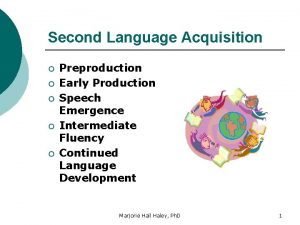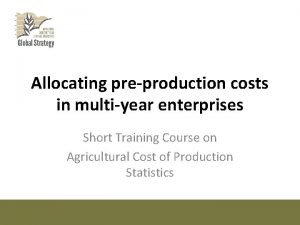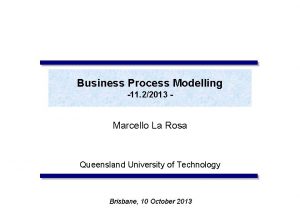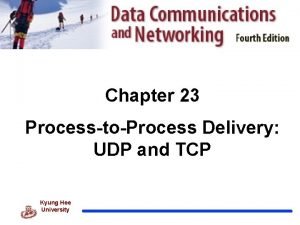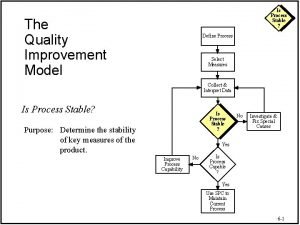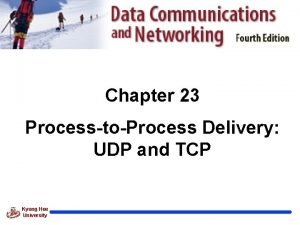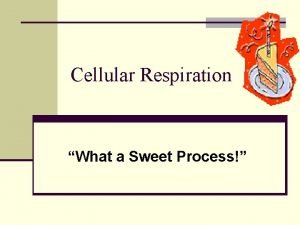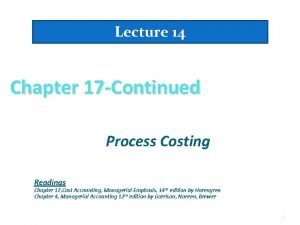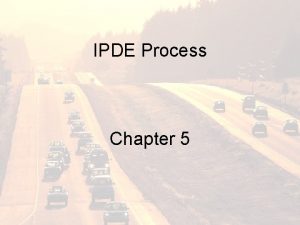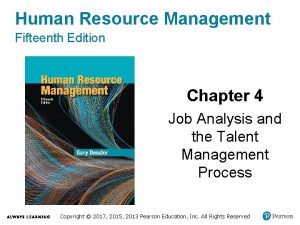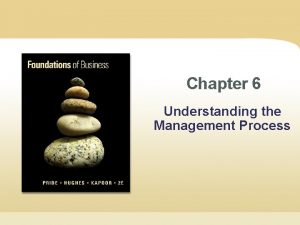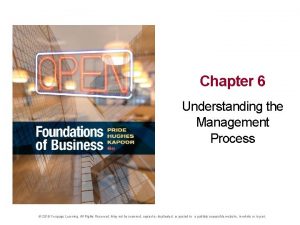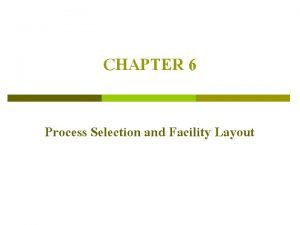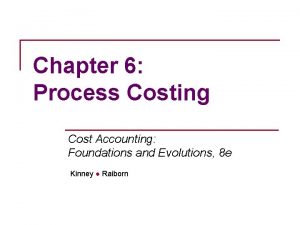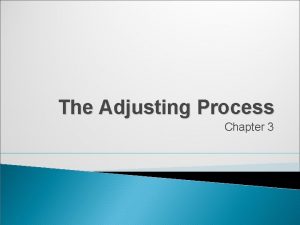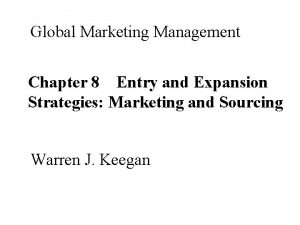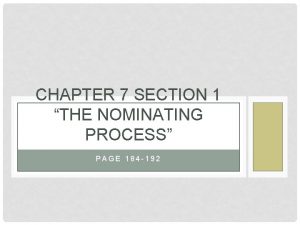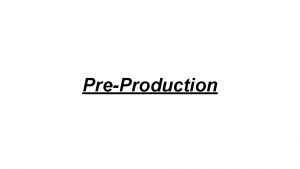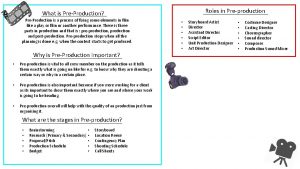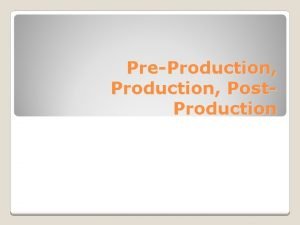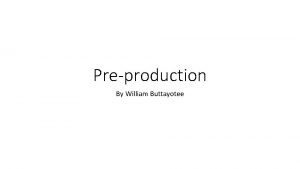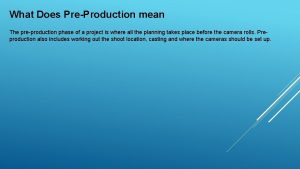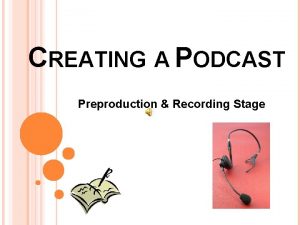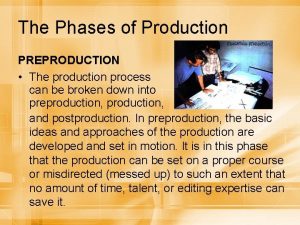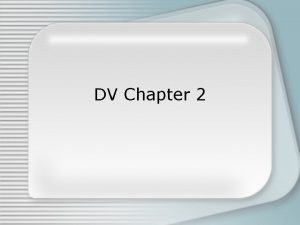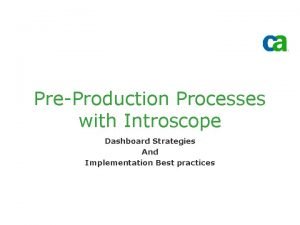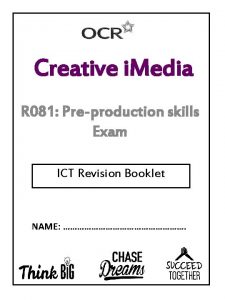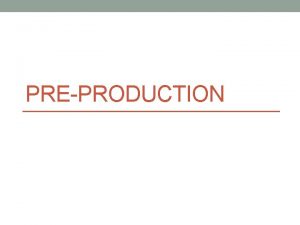Chapter 4 PreProduction Process Chapter 4 PreProduction Process

































- Slides: 33

Chapter 4 Pre-Production Process

Chapter 4 Pre-Production Process Overview • • • Project Definition and Planning Functional Requirements Content and Media Assets Organization Basic Project Management Concepts Production Phases

Chapter 4 Project Definition and Planning • Initial Meeting – – – Ask critical questions Assess needs of the client Establish goals of the project Understand client’s expectations Brainstorm with client • • Collect ideas Establish flowchart Suggest initial website features Write vision statement

Chapter 4 Project Definition and Planning • Client Management – – – Know client’s business Be prepared to listen Demonstrate your services and abilities Show enthusiasm and professionalism Use list of customer profile questions

Chapter 4 Project Definition and Planning • Scope Definition – How much detail needs to be presented? – What is the scope of the competitors’ sites? – What is the customer’s time and budget?

Chapter 4 Project Definition and Planning Scope Definition

Chapter 4 Project Definition and Planning • Website roles – Project manager – Graphic artist – Coder – Programmer – Writer – Outsourcing specialty positions

Chapter 4 Project Definition and Planning • Other important tasks – Identify main client contact – Conduct competition survey – Establish available time and budget – Develop proposal to client

Chapter 4 Project Definition and Planning • Proposal development – Detailed itemization of website’s elements – Budget – Target dates – Creative concept – Initial flow chart – Start and end date – Signatures of all parties concerned

Chapter 4 Project Definition and Planning • Contracts Def: an agreement among two or more parties who promise to perform a transaction with each other – Contract elements • Oral and written agreements • Enforceable contracts

Chapter 4 Project Definition and Planning • Negotiation Preparation – Originate first contract draft yourself – Draft contract with room for negotiation – Be prepared for revisions – Review prepared contracts with an attorney – Sign contract after reading it – Make concessions equal from both parties

Chapter 4 Functional Requirements • Content and Media Assets – Gather copy, logos, photographs, illustrations, audio files – Organize assets into logical and meaningful groups – Size and scope – Multimedia – Background information – Static vs. dynamic content

Chapter 4 Functional Requirements • Stakeholder interviews – Used to learn more about nature and details of the organization or business – Gather as much information about each facet of business as possible

Chapter 4 Functional Requirements • Information architecture – Structure website hierarchically – Categorize and prioritize information to be used – Categorize and prioritize content – Establish navigation scheme – Establish user interface

Chapter 4 Functional Requirements Website hierarchy diagram

Chapter 4 Functional Requirements • Information Architecture cautions – Avoid clutter – Emphasize navigation buttons and links – Segregate information by page or area – Provide a site flowchart for potential changes by client

Chapter 4 Functional Requirements Site flow chart

Chapter 4 Functional Requirements • Content update plan – World Wide Web lends itself to change – Needed if regular content updates are part of the site – Specifies which pages need to be updated – Specifies dates when updates take place

Chapter 4 Functional Requirements • Requirements document – Specifies what the client needs to provide to the designer – Specifies what the designer needs to do his job – Specifies what the designer will do – Includes a detailed, revised flow chart – Requires client sign-off to begin

Chapter 4 Functional Requirements • Establish Time Line and Schedule – Establish realistic amount of time to accomplish task – Adhere closely to established schedule – Establish timeline based on milestones – Timeline should include due dates for contributions by both you and your client

Chapter 4 Functional Requirements Sample Time Line

Chapter 4 Content and Media Organization • File management – Start with general client folder at top of hierarchy – Create sub-folders for all content collected – Organize content by type – Prepare to move certain assets to local Web folder for later FTP to Web site – Creation of relative and absolute pathnames

Chapter 4 Content and Media Organization • Backup process – Keep backup files identical to files on your computer – Be prepared to return original assets to client – Backup devices • ZIP or JAZ • External hard drive(s) • CR-R or CD-RW

Chapter 4 Content and Media Organization • Media assets conversion – Provide client with acceptable media formats that you can concert – Image file formats • GIF, JPG, PNG – Video formats • SWF, AVI, QT, MPG, WAV

Chapter 4 Content and Media Organization • File Naming Conventions – Homepage names (check with ISP) • index. htm, index. html, index. asp, etc. – Use file naming convention key • bg" for background or "pg" for page • Location abbreviations – Top, center, left, footer • Mouseover abbreviations – “up" for mouseup, "dn" for mousedown, "ov" for mouseover, and "reg" for the regular state

Chapter 4 Basic Project Management Concepts • Project management overview Def: organizing and structuring a systematic sequence of activities to most efficiently develop the website – Keeps project on schedule – Ensures smooth production process – Organizes Web development activities – Planning pre-production, and postproduction phases

Chapter 4 Basic Project Management Concepts • Key terms and definitions – – – – – Process Project Phase Table Deliverable Milestones Team Exit points Requirements document

Chapter 4 Basic Project Management Concepts • Scheduling Tools – Microsoft Scheduler, Visio – Built-in features of tools software results in more coherent and easily-read project plans

Chapter 4 Basic Project Management Concepts Microsoft Scheduler

Chapter 4 Production Phases • Pre-Production – preliminary phase of website development • making initial contact with your client • assessing the client's needs • developing ideas to best present the client to the world • Tasks – determine a budget – schedule proposal – configure a project flow chart.

Chapter 4 Production Phases • Production – Review of the materials to refine your decisions • what to retain • what to omit

Chapter 4 Production Phases

Chapter 4 Production Phases • Post-Production – Testing phase • Site free of errors, broken links, operational deficiencies • Site proofread – Upload phase • Site uploaded to a server, tested, and retested – Index phase • Site indexed to major search engines
 Preproduction early production speech emergence
Preproduction early production speech emergence Preproduction costs
Preproduction costs Os coxae
Os coxae Liberty chapter 20
Liberty chapter 20 Business process levels
Business process levels Ergodicity
Ergodicity What is process to process delivery
What is process to process delivery Condylar and coronoid process of mandible
Condylar and coronoid process of mandible Minitab
Minitab Process-to-process delivery
Process-to-process delivery Sweet process
Sweet process Sweet evaluation
Sweet evaluation Zeta phi beta national prayer
Zeta phi beta national prayer Chapter 17 process costing
Chapter 17 process costing What factors can cause the ipde process to take more time
What factors can cause the ipde process to take more time Human resource management chapter 4
Human resource management chapter 4 Chapter 6 understanding the management process
Chapter 6 understanding the management process Understanding the management process
Understanding the management process Chapter 6 process selection and facility layout
Chapter 6 process selection and facility layout A common goal in designing process layouts is:
A common goal in designing process layouts is: When you apply the ipde process
When you apply the ipde process Ipde driving
Ipde driving Managing risk with the ipde process
Managing risk with the ipde process Chapter 13 beginning the sales process worksheet answer key
Chapter 13 beginning the sales process worksheet answer key Chapter 2 the recording process
Chapter 2 the recording process Chapter 7 the electoral process
Chapter 7 the electoral process Chapter 6 process costing
Chapter 6 process costing Adjusting entries are natural opposites
Adjusting entries are natural opposites Chapter 8 the international market selection process
Chapter 8 the international market selection process Chapter 8 managing distractions
Chapter 8 managing distractions Chapter 7 section 1 the nominating process
Chapter 7 section 1 the nominating process Chapter 5 assisting with the nursing process
Chapter 5 assisting with the nursing process Orderly visual search pattern
Orderly visual search pattern Drawings debit or credit
Drawings debit or credit
